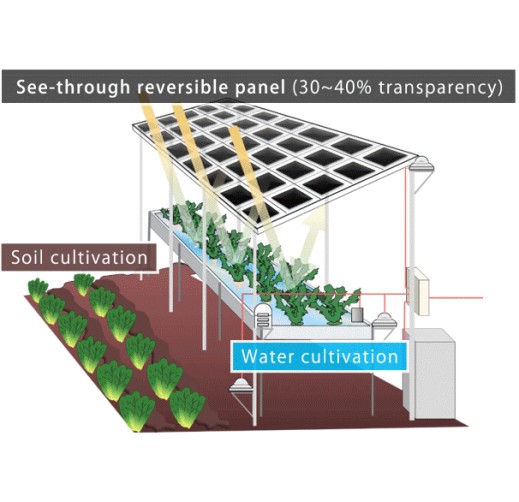「Solar Farm」 Renewable energy and agriculture production from the same plot of land

FARMLAND Co., Ltd.
Overseas Department
Technology / Service Summary
「Solar Farm」 allows for an increase of land use efficiency unlocking its potential to provide both renewable energy and food self-sufficiency at the same time.
Purpose
「Solar Farm」 through the adoption of bi-facial, transparent solar panels Solar Farm is able to maximize renewable energy production while allowing for appropriate amounts of light to reach crops below the solar array so that agriculture production can maintain near normal levels. Also, Solar Farm can improve farmers' incomes in order to increase the interest of young people in agriculture and the new farmers joint the agriculture.
Feature
FARMLAND contributes to people and the global environment by creating and offering safer and enrich life environment. 「Solar Farm」 creates a new ideal style of agriculture for young generations.
Effect
Any loss in agriculture production can be made up through electricity sales or savings from solar. That is the way we contribute to society.
Controlled Substance
Reference
Applicable Regions / Countries
- Japan
- Southeast Asia
- Central/South Asia
- China/ East Asia
- Africa
- Europe
- Central/South America
- ASEAN countries
Singapore,Thailand,Philippines,Viet Nam,Malaysia,Myanmar,Lao PDR
Accomplishments
Solar Farm has got its patent in Japan, USA, China & Taiwan.
In 2017 has obtained Polaris Medal. Our activity was taken up in Whitepaper issued by MOE in 2019 and registered in 「Good Practice for adaptation against climate change」by METI in 2020/2021/2022/2023.
In 2020 an MoU was concluded with the Chilean Ministry of Agriculture to implement a 20kW Solar Farm pilot project. Its construction will be completed in Q1 of 2022 wherby studies will commence to identify the ways to best adapt the system for farmers of Chile. In Mongolia, 2017, through the support of the Joint Credit Mechanism susbidy from the Japanese government a 10.4MWac (12.7 MWdc) solar system which incorporates Solar Farm began its operations in Mongolia.
In Japan, since 2015 Farmdo Group has constructed, maintained and managed over 50 Solar Farm locations.
Reference URL
Locations for inspection
Farmdo-Nakasato Farm, Nakasato, Takasaki, Gunma, Japan. Postal Code 370-3532.
INIA Raihuen, Villa Alegre, Maule, Chile.
Related SDGs Goals
- 2. Zero Hunger
- 7. Affordable and Clean Energy
- 9. Industry, Innovation and Infrastructure
- 11. Sustainable Cities and Communities
- 13. Climate Action
JCM Project
[Chile]3MW Solar Power Project Utilizing Farmland in Valparaiso Region; [Mongolia]Installation of 2.1MW Solar Power Plant for Power Supply in Ulaanbaatar Suburb; Installation of 8.3MW Solar Power Plant in Ulaanbaatar suburb Farm
Notes
Framland JCM project of Chile:
This project consists of 3MW solar plant for Valparaiso Region and 20KW Solar Farm for Maule Region.
Together with Chilean Ministry of Agriculture and Irrigation, a 20kW facility introduced in Maule Region. By promoting this agrivoltaic pilot project to local farmers, the project contributes additional emission reduction of GHG.
This project contributes to the achievement of Chile’s policy for a renewable energy ratio target of 70% in 2050.
Framland JCM project of Mongolia:
Located in Ulaanbaatar city (39 km from the city centre), the Monnaran Solar Power Plant is a mega solar power plant with 10.4 MW of solar panels, completed in 2017.
A Solar Farm has been installed on a 28 ha site that was previously used as a farm, and the project implements an agriculture + solar power + CO2 credits project.
https://gec.jp/jcm/projects/16pro_mgl_01/
https://gec.jp/jcm/projects/15pro_mgl_02/


